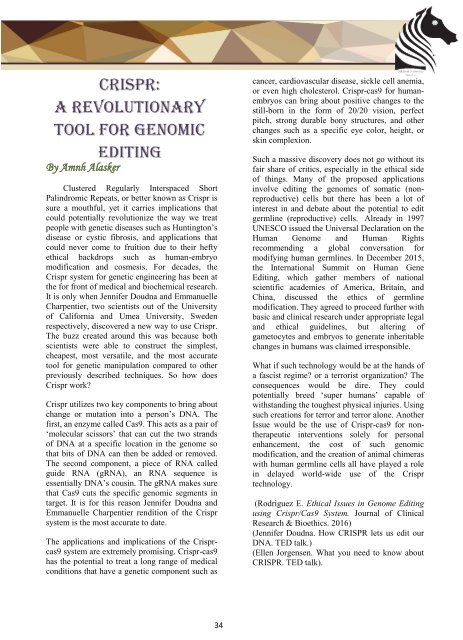Newspaper Khebrat Wave2 Oakland 2018
You also want an ePaper? Increase the reach of your titles
YUMPU automatically turns print PDFs into web optimized ePapers that Google loves.
cancer, cardiovascular disease, sickle cell anemia,<br />
or even high cholesterol. Crispr-cas9 for humanembryos<br />
can bring about positive changes to the<br />
still-born in the form of 20/20 vision, perfect<br />
pitch, strong durable bony structures, and other<br />
changes such as a specific eye color, height, or<br />
skin complexion.<br />
By Amnh Alasker<br />
Clustered Regularly Interspaced Short<br />
Palindromic Repeats, or better known as Crispr is<br />
sure a mouthful, yet it carries implications that<br />
could potentially revolutionize the way we treat<br />
people with genetic diseases such as Huntington’s<br />
disease or cystic fibrosis, and applications that<br />
could never come to fruition due to their hefty<br />
ethical backdrops such as human-embryo<br />
modification and cosmesis. For decades, the<br />
Crispr system for genetic engineering has been at<br />
the for front of medical and biochemical research.<br />
It is only when Jennifer Doudna and Emmanuelle<br />
Charpentier, two scientists out of the University<br />
of California and Umea University, Sweden<br />
respectively, discovered a new way to use Crispr.<br />
The buzz created around this was because both<br />
scientists were able to construct the simplest,<br />
cheapest, most versatile, and the most accurate<br />
tool for genetic manipulation compared to other<br />
previously described techniques. So how does<br />
Crispr work?<br />
Crispr utilizes two key components to bring about<br />
change or mutation into a person’s DNA. The<br />
first, an enzyme called Cas9. This acts as a pair of<br />
‘molecular scissors’ that can cut the two strands<br />
of DNA at a specific location in the genome so<br />
that bits of DNA can then be added or removed.<br />
The second component, a piece of RNA called<br />
guide RNA (gRNA), an RNA sequence is<br />
essentially DNA’s cousin. The gRNA makes sure<br />
that Cas9 cuts the specific genomic segments in<br />
target. It is for this reason Jennifer Doudna and<br />
Emmanuelle Charpentier rendition of the Crispr<br />
system is the most accurate to date.<br />
The applications and implications of the Crisprcas9<br />
system are extremely promising. Crispr-cas9<br />
has the potential to treat a long range of medical<br />
conditions that have a genetic component such as<br />
Such a massive discovery does not go without its<br />
fair share of critics, especially in the ethical side<br />
of things. Many of the proposed applications<br />
involve editing the genomes of somatic (nonreproductive)<br />
cells but there has been a lot of<br />
interest in and debate about the potential to edit<br />
germline (reproductive) cells. Already in 1997<br />
UNESCO issued the Universal Declaration on the<br />
Human Genome and Human Rights<br />
recommending a global conversation for<br />
modifying human germlines. In December 2015,<br />
the International Summit on Human Gene<br />
Editing, which gather members of national<br />
scientific academies of America, Britain, and<br />
China, discussed the ethics of germline<br />
modification. They agreed to proceed further with<br />
basic and clinical research under appropriate legal<br />
and ethical guidelines, but altering of<br />
gametocytes and embryos to generate inheritable<br />
changes in humans was claimed irresponsible.<br />
What if such technology would be at the hands of<br />
a fascist regime? or a terrorist organization? The<br />
consequences would be dire. They could<br />
potentially breed ‘super humans’ capable of<br />
withstanding the toughest physical injuries. Using<br />
such creations for terror and terror alone. Another<br />
Issue would be the use of Crispr-cas9 for nontherapeutic<br />
interventions solely for personal<br />
enhancement, the cost of such genomic<br />
modification, and the creation of animal chimeras<br />
with human germline cells all have played a role<br />
in delayed world-wide use of the Crispr<br />
technology.<br />
(Rodriguez E. Ethical Issues in Genome Editing<br />
using Crispr/Cas9 System. Journal of Clinical<br />
Research & Bioethics. 2016)<br />
(Jennifer Doudna. How CRISPR lets us edit our<br />
DNA. TED talk.)<br />
(Ellen Jorgensen. What you need to know about<br />
CRISPR. TED talk).<br />
34


